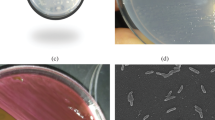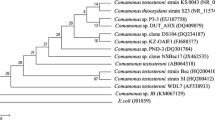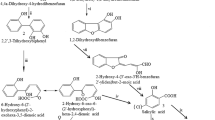Abstract
The bacterium, Rhodococcus erythropolis H-2, which can utilize dibenzothiophene (DBT) as a sole source of sulfur in the presence of hydrocarbon, was isolated from soil samples. When this strain was cultivated in a medium containing 0.27 mM DBT and 40% n-tetradecane, DBT was metabolized stoichiometrically to 2-hydroxybiphenyl within 1 day. This strain grew in the presence of n-octane and longer-carbonchain hydrocarbons, but not with n-hexane, styrene, p-xylene, cyclooctane or toluene. DBT degradation proceeded in the resting cell system with lyophilized cells of this strain. The addition of n-tetradecane enhanced the reaction rate, the optimal concentration being 40%. DBT degradation occurred in the reaction mixture even in the presence of 70% n-tetradecane, whereas at concentrations above 80% n-tetradecane suppressed the degradation.
Similar content being viewed by others
References
Afferden M van, Schacht S, Klein J, Trüper HG (1990) Degradation of dibenzothiophene by Brevibacterium sp. DO. Arch Microbiol 153:324–328
Crawford DL, Gupta RK (1990) Oxidation of dibenzothiophene by Cunninghamella elegans. Curr Microbiol 21:229–231
Denome SA, Olson ES, Young KD (1993) Identification and cloning of genes involved in specific desulfurization of dibenzothiophene by Rhodococcus sp. strain IGTS8. Appl Environ Microbiol 59:2837–2843
Gallagher JR, Olson ES, Stanley DC (1993) Microbial desulfurization of dibenzothiophene: a sulfur-specific pathway. FEMS Microbiol Lett 107:31–36
Hansch C, Fujita T (1964) A method for the correlation of biological activity and chemical structure. J Am Chem Soc 86: 1616–1626
Hansch C, Muir MR, Fujita T, Maloney PP, Geiger F, Streich M (1963) The correlation of biological activity of plant growth regulators and chloromycetin derivatives with hammet constants and partition coefficients. J Am Chem Soc 85:2817–2824
Inoue A, Horikoshi K (1991) Estimation of solvent-tolerance of bacteria by the solvent parameter Log P. J Ferment Bioeng 71:194–196
Izumi Y, Ohshiro T, Ogino H, Hine Y, Shimao M (1994) Selective desulfurization of dibenzothiophene by Rhodococcus erythropolis D-1. Appl Environ Microbiol 60:223–226
Kayser KJ, Bielaga-Jones BA, Jackowski K, Odusan O, Kilbane II JJ (1993) Utilization of organosulfur compounds by axenic and mixed cultures of Rhodococcus rhodochrous IGTS8. J Gen Microbiol 139:3123–3129
Kilbane JJ, Bielaga BA (1990) Toward sulfur-free fuels. Chemtech 20:747–751
Kilbane II JJ, Jackowski K (1992) Biodesulfurization of water-soluble coal-derived material by Rhodococcus rhodochrous IGTS8. Biotechnol Bioeng 40:1107–1114
Kim HY, Kim TS, Kim BH (1990) Degradation of organic sulfur compounds and the reduction of dibenzothiophene to biphenyl and hydrogen sulfide by Desulfovibrio desulfuricans Mb. Biotechnol Lett 12:761–764
Kodama K, Nakatani S, Umehara K, Shimizu K, Minoda Y, Yamada K (1970) Microbial conversion of petro-sulfur compounds Part III. Isolation and identification of products from dibenzothiophene. Agric Biol Chem 34:1320–1324
Laborde AL, Gibson DT (1977) Metabolism of dibenzothiophene by a Beijerinckia species. Appl Environ Microbiol 34:783–790
Monticello DJ, Bakker D, Finnerty WR (1985) Plasmid-mediated degradation of dibenzothiophene by Pseudomonas species. Appl Environ Microbiol 49:756–760
Ohshiro T, Hine Y, Izumi Y (1994) Enzymatic desulfurization of dibenzothiophene by a cell-free system of Rhodococcus erythropolis D-1. FEMS Microbiol Lett 118:341–344
Olson ES, Stanley DC, Gallagher JR (1993) Characterization of intermediates in the microbial desulfurization of dibenzothiophene. Energy Fuels 7:159–164
Omori T, Monna L, Saiki Y, Kodama T (1992) Desulfurization of dibenzothiophene by Corynebacterium sp. strain SY1. Appl Environ Microbiol 58:911–915
Setti L, Rossi M, Lanzarini G, Pifferi PG (1992) The effect of n-alkanes in the degradation of dibenzothiophene and of organic sulfur compounds in heavy oil by a Pseudomonas sp. Biotechnol Lett 14:515–520
Wang P, Krawiec S (1994) Desulfurization of dibenzothiophene to 2-hydroxybiphenyl by some newly isolated bacterial strains. Arch Microbiol 161:266–271
Author information
Authors and Affiliations
Rights and permissions
About this article
Cite this article
Ohshiro, T., Hirata, T. & Izumi, Y. Microbial desulfurization of dibenzothiophene in the presence of hydrocarbon. Appl Microbiol Biotechnol 44, 249–252 (1995). https://doi.org/10.1007/BF00164510
Received:
Revised:
Accepted:
Issue Date:
DOI: https://doi.org/10.1007/BF00164510




